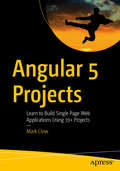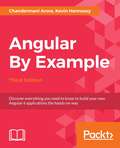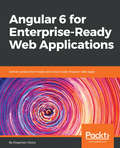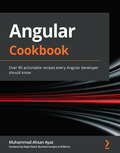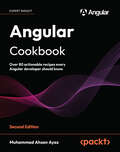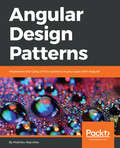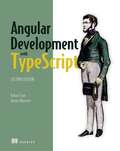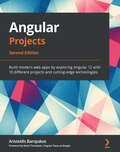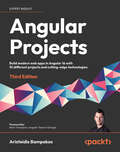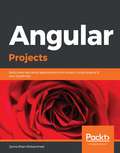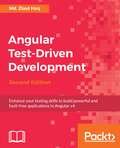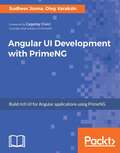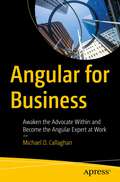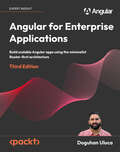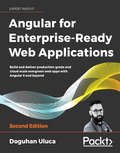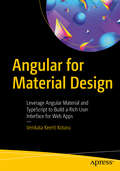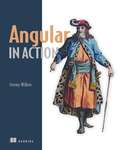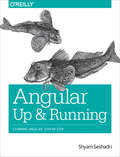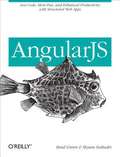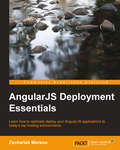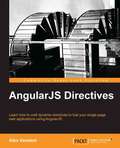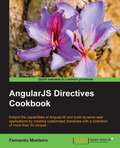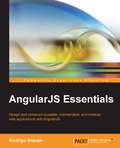- Table View
- List View
Angular 5 Projects: Learn to Build Single Page Web Applications Using 70+ Projects
by Mark ClowLearn to build single page web apps using Angular 5 and TypeScript by working through 70+ mini-projects. With hundreds of code examples you gain a thorough understanding of the Angular 5 ecosystem and how to work within it. <P><P> You'll begin by understanding the benefits of Angular 5 vs older versions, and how this benefits your applications. You'll then move onto mini-projects that teach you JavaScript, TypeScript, how to use editors, Node, CLI, components, modules, directives, Webpack, dependency injection, widgets, routes and navigation, observers, reactive programming, and RxJS. <P> Complete with a consistently-updated online code repository, this book is a great way to get started with Angular 5.
Angular 6 by Example: Get up and running with Angular by building modern real-world web apps, 3rd Edition
by Chandermani Arora Kevin HennessyHarness the power of Angular Components, Router, Forms, Directives and much more to build professional-grade web apps with TypeScriptKey FeaturesGet to grips with #1 JavaScript framework and explore modern concepts for developing single page applicationsDevelop full-featured web applications using Angular 6 and TypeScript from scratchLearn professional web programming techniques to supercharge your Angular projectsBook DescriptionAngular helps you build faster, more efficient, and more flexible cross-platform applications. Creating complex and rich web applications, with a lighter resource footprint, has never been easier or faster. Angular is now at release 6, with significant changes compared to previous versions.In this third edition of Angular by Example, you’ll build three apps with varying degrees of complexity. The book starts with a simple Guess the Number game, which serves as a platform to launch you into the world of Angular. Next, you will learn to develop a popular 7-Minute Workout app, covering the building blocks of Angular. The final app, “Personal Trainer” morphs the existing 7-Minute Workout into a full-fledged personal workout builder and runner, covering advanced directive building, which is the most fundamental and powerful feature of Angular. In addition to this, you will learn about testability and the framework constructs Angular provides to effectively test your app. The book concludes by providing you with practical advice and useful tips that will come in handy as you build more apps with Angular.What you will learnGet introduced to the Angular framework and create a simple guess the number app that explores core features of the framework Dig deeper into the angular framework by building the 7-minute workout app throughout the bookExplore primary building blocks of Angular – components Go deep into the inner workings of Angular 6 directives and componentsLearn about cross-component communication using Angular eventsGet started with the unit and E2E testingUnderstand how to encounter scenarios such as authentication and authorization, localization, performance, and migrating apps from Angular 1 to Angular 6Who this book is forAngular by Example is an essential guide for beginners who want to get started with Angular. You’ll start building applications immediately with the featured examples and uncover a simpler approach to JavaScript web development. Prior experience with HTML, CSS, and JavaScript is necessary.
Angular 6 for Enterprise-Ready Web Applications: Deliver production-ready and cloud-scale Angular web apps
by Doguhan UlucaA hands-on guide with a minimalist and flexible approach that enables quick learning and rapid delivery of cloud-ready enterprise applications with Angular 6Key FeaturesExplore tools and techniques to push your web app to the next levelMaster Angular app design and architectural considerationsLearn continuous integration and deploy your app on a highly available cloud infrastructure in AWS Book DescriptionAngular 6 for Enterprise-Ready Web Applications follows a hands-on and minimalist approach demonstrating how to design and architect high quality apps.The first part of the book is about mastering the Angular platform using foundational technologies. You will use the Kanban method to focus on value delivery, communicate design ideas with mock-up tools and build great looking apps with Angular Material. You will become comfortable using CLI tools, understand reactive programming with RxJS, and deploy to the cloud using Docker.The second part of the book will introduce you to the router-first architecture, a seven-step approach to designing and developing mid-to-large line-of-business applications, along with popular recipes. You will learn how to design a solid authentication and authorization experience; explore unit testing, early integration with backend APIs using Swagger and continuous integration using CircleCI. In the concluding chapters, you will provision a highly available cloud infrastructure on AWS and then use Google Analytics to capture user behavior.By the end of this book, you will be familiar with the scope of web development using Angular, Swagger, and Docker, learning patterns and practices to be successful as an individual developer on the web or as a team in the Enterprise.What you will learn Create full-stack web applications using Angular and RESTful APIs Master Angular fundamentals, RxJS, CLI tools, unit testing, GitHub, and Docker Design and architect responsive, secure and scalable apps to deploy on AWS Adopt a minimalist, value-first approach to delivering your app with Kanban Get introduced to automated testing with continuous integration on CircleCI Optimize Nginx and Node.js web servers with load testing toolsWho this book is forThis book is for developers who want to confidently deliver high-quality and production-grade Angular apps from design to deployment. We assume that you have prior experience in writing a RESTful API with the tech stack of your choice; if you don't, you can still gain a lot of benefit from this book, which focuses on the entire scope of frontend development, from design to deployment!
Angular Cookbook: Over 80 actionable recipes every Angular developer should know
by Muhammad Ahsan AyazDiscover actionable solutions to everyday problems in building applications with Angular and TypeScript, from app design to production deploymentKey FeaturesExplore recipes across core Angular topics to fill gaps in your knowledge of using Angular in productionDiscover industry best practices and tooling to enhance your development experience with AngularUnderstand advanced topics in Angular to help you become a proficient enterprise web developerBook DescriptionThe Angular framework, powered by Google, is the framework of choice for many web development projects built across varying scales. It’s known to provide much-needed stability and a rich tooling ecosystem for building production-ready web and mobile apps. This recipe-based guide enables you to learn Angular concepts in depth using a step-by-step approach. You’ll explore a wide range of recipes across key tasks in web development that will help you build high-performance apps.The book starts by taking you through core Angular concepts such as Angular components, directives, and services to get you ready for building frontend web apps. You’ll develop web components with Angular and go on to cover advanced concepts such as dynamic components loading and state management with NgRx for achieving real-time performance. Later chapters will focus on recipes for effectively testing your Angular apps to make them fail-safe, before progressing to techniques for optimizing your app’s performance. Finally, you’ll create Progressive Web Apps (PWA) with Angular to provide an intuitive experience for users.By the end of this Angular book, you’ll be able to create full-fledged, professional-looking Angular apps and have the skills you need for frontend development, which are crucial for an enterprise Angular developer.What you will learnGain a better understanding of how components, services, and directives work in AngularUnderstand how to create Progressive Web Apps using Angular from scratchBuild rich animations and add them to your Angular appsManage your app’s data reactivity using RxJSImplement state management for your Angular apps with NgRxOptimize the performance of your new and existing web appsWrite fail-safe unit tests and end-to-end tests for your web apps using Jest and CypressGet familiar with Angular CDK components for designing effective Angular componentsWho This Book Is ForThe book is for web developers and mobile developers alike with beginner-level Angular experience. Prior experience with using JavaScript and TypeScript is also required to grasp the topics covered in this book more effectively.Table of ContentsUpgrading to Angular 10Winning Components CommunicationImplementing Angular Directives The Magic of Dependency Injection (DI) in AngularUnderstanding Angular AnimationsAngular and RxJs in Action: Awesomeness CombinedReactive State Management with NgRxUnderstanding Angular Navigation and RoutingMastering Angular FormsAngular & Angular CDK - Awesomeness CombinedUnit Testing in Angular with JestEnd-to-End Testing in Angular with CypressPerformance OptimizationsCreating PWAs with Angular
Angular Cookbook: Over 80 actionable recipes every Angular developer should know
by Muhammad Ahsan AyazDiscover core concepts, advanced techniques, and end-to-end solutions for building production-ready applications Purchase of the print or Kindle book includes a free PDF eBook.Key FeaturesExplore updated and new recipes to fill gaps in your knowledge while using Angular in productionDiscover industry best practices and tooling to enhance your development experience with Angular’s renaissanceGain an understanding of advanced Angular topics to become a proficient enterprise web developerBook DescriptionAngular has long been the framework of choice for web development projects of various scales, offering much-needed stability and a rich tooling ecosystem for building production-ready web and mobile apps. This recipe-based guide ensures high performance apps with the latest version of Angular, helping you to build up your Angular expertise with a wide range of recipes across key tasks in web development. In this second edition, the recipes have been updated, added, and improved based on developer feedback, new challenges, and Angular 17. The first few chapters will show you how to utilize core Angular concepts such as components, directives, and services to get you ready for building frontend web apps. You’ll then develop web components with Angular and go on to learn about advanced concepts such as dynamic components loading and state management with NgRx for achieving real-time performance. Later chapters will focus on recipes for effectively testing your Angular apps to make them fail-safe, before progressing to techniques for optimizing your app’s performance. Finally, you’ll create Progressive Web Apps (PWA) with Angular to provide an intuitive experience for users. By the end of this book, you’ll be able to create full-fledged, professional-looking Angular apps and have the skills you need for frontend development. What you will learnGain a better understanding of how components, services, and directives work in AngularGet to grips with creating Progressive Web Apps using Angular from scratchBuild rich animations and add them to your Angular appsManage your app's data reactivity using RxJSImplement state management for your Angular apps with NgRxOptimize the performance of your new and existing web appsWrite fail-safe unit tests and end-to-end tests for your web apps using Jest and CypressGet familiar with Angular CDK components for designing effective Angular componentsWho this book is forThis book is for intermediate-level Angular developers looking for actionable solutions to common problems in Angular enterprise development. Mobile developers using Angular will also find the recipes in this book useful. Working experience with JavaScript and TypeScript is necessary to understand the topics covered in this book more effectively.
Angular Design Patterns: Implement the Gang of Four patterns in your apps with Angular
by Mathieu NayrollesMake the most of Angular by leveraging design patterns and best practices to build stable and high performing appsKey FeaturesGet to grips with the benefits and applicability of using different design patterns in Angular with the help of real-world examplesIdentify and prevent common problems, programming errors, and anti-patternsPacked with easy-to-follow examples that can be used to create reusable code and extensible designsBook DescriptionThis book is an insightful journey through the most valuable design patterns, and it will provide clear guidance on how to use them effectively in Angular. You will explore some of the best ways to work with Angular and how to use it to meet the stability and performance required in today's web development world. You’ll get to know some Angular best practices to improve your productivity and the code base of your application.We will take you on a journey through Angular designs for the real world, using a combination of case studies, design patterns to follow, and anti-patterns to avoid.By the end of the book, you will understand the various features of Angular, and will be able to apply well-known, industry-proven design patterns in your work.What you will learnUnderstand Angular design patterns and anti-patternsImplement the most useful GoF patterns for Angular Explore some of the most famous navigational patterns for Angular Get to know and implement stability patternsExplore and implement operations patternsExplore the official best practices for Angular Monitor and improve the performance of Angular applicationsWho this book is forIf you want to increase your understanding of Angular and apply it to real-life application development, then this book is for you.
Angular Development with TypeScript
by Yakov Fain Anton MoiseevSummaryAngular Development with TypeScript, Second Edition is an intermediate-level tutorial that introduces Angular and TypeScript to developers comfortable with building web applications using other frameworks and tools.Purchase of the print book includes a free eBook in PDF, Kindle, and ePub formats from Manning Publications.About the TechnologyWhether you're building lightweight web clients or full-featured SPAs, Angular is a clear choice. The Angular framework is fast, efficient, and widely adopted. Add the benefits of developing in the statically typed, fully integrated TypeScript language, and you get a programming experience other JavaScript frameworks just can't match.About the BookAngular Development with TypeScript, Second Edition teaches you how to build web applications with Angular and TypeScript. Written in an accessible, lively style, this illuminating guide covers core concerns like state management, data, forms, and server communication as you build a full-featured online auction app. You'll get the skills you need to write type-aware classes, interfaces, and generics with TypeScript, and discover time-saving best practices to use in your own work.What's insideCode samples for Angular 5, 6, and 7Dependency injectionReactive programmingThe Angular Forms APIAbout the ReaderWritten for intermediate web developers familiar with HTML, CSS, and JavaScript.About the AuthorYakov Fain and Anton Moiseev are experienced trainers and web application developers. They have coauthored several books on software development.Table of ContentsIntroducing AngularThe main artifacts of an Angular appRouter basicsRouter advancedDependency injection in AngularReactive programming in AngularLaying out pages with Flex LayoutImplementing component communicationsChange detection and component lifecycleIntroducing the Forms APIValidating formsInteracting with servers using HTTPInteracting with servers using the WebSocket protocolTesting Angular applicationsMaintaining app state with ngrx
Angular Projects: Build modern web apps by exploring Angular 12 with 10 different projects and cutting-edge technologies, 2nd Edition
by Mark Thompson Aristeidis BampakosUnderstand Angular web application development by building captivating real-world applications while exploring modern web technologies and best practicesKey FeaturesExplore Angular's capabilities for building applications across different platformsCombine popular web technologies with Angular such as monorepo, Jamstack, and PWABuild your own libraries and schematics using Angular CDK and Angular CLIBook DescriptionAngular is a popular JavaScript framework that can run on a broad range of platforms including web, desktop, and mobile. It has an array of rich features right out of the box and a wide range of tools that makes it popular among developers. This updated second edition of Angular Projects will teach you how to build efficient and optimized web applications using Angular. You will start by exploring the essential features of the framework by creating ten different real-world web applications. Each application will demonstrate how to integrate Angular with a different library and tool. As you advance, you will understand how to implement popular technologies such as Angular Router, Scully, Electron, Angular service worker, Nx monorepo tools, NgRx, and more while building an issue tracking system, a PWA weather application, a mobile photo geotagging application, a component UI library, and many other exciting projects. Toward the concluding chapters, you'll get to grips with customizing Angular CLI commands using schematics. By the end of this book, you will have the skills you need to be able to build Angular apps using a variety of different technologies according to your or your client's needs.What you will learnSet up Angular applications using Angular CLI and Nx ConsoleCreate a personal blog with Jamstack and SPA techniquesBuild desktop applications with Angular and ElectronEnhance user experience (UX) in offline mode with PWA techniquesMake web pages SEO-friendly with server-side renderingCreate a monorepo application using Nx tools and NgRx for state managementFocus on mobile application development using IonicDevelop custom schematics by extending Angular CLIWho this book is forIf you are a developer who has beginner-level experience with Angular and are looking to become well-versed with essential tools and deal with the various use cases you may encounter with Angular, then this Angular development book is for you. Beginner-level knowledge of web application development and basic experience working with ES6 or TypeScript are assumed.
Angular Projects: Build modern web apps in Angular 16 with 10 different projects and cutting-edge technologies
by Aristeidis BampakosTake Angular to the next level – build captivating real-world applications while exploring modern web technologies and best practices Purchase of the print or Kindle book includes a free PDF eBookKey FeaturesExplore Angular's capabilities for cross-platform app developmentCombine Angular with popular web technologies such as Nx monorepos, server-side rendering, and progressive web appsBuild your own libraries and schematics using Angular CDK and Angular CLBook DescriptionAngular Projects isn't like other books on Angular – this is a project-based guide that helps budding Angular developers get hands-on experience while developing cutting-edge applications. In this updated third edition, you’ll master the essential features of the framework by creating ten different real-world web applications. Each application will demonstrate how to integrate Angular with a different library and tool, giving you a 360-degree view of what the Angular ecosystem makes possible. Updated to the newest version of Angular, the book has been revamped to keep up with the latest technologies. You’ll work on a PWA weather application, a mobile photo geotagging application, a component UI library, and other exciting projects. In doing so, you’ll implement popular technologies such as Angular Router, Scully, Electron, Angular service workers, Jamstack, NgRx, and more. By the end of this book, you will have the skills you need to build Angular apps using a variety of different technologies according to your or your client’s needs.What you will learnSet up Angular applications using Angular CLI and Nx ConsoleCreate a personal blog with Jamstack, Scully plugins, and SPA techniquesBuild an issue management system using typed reactive formsUse PWA techniques to enhance user experienceMake SEO-friendly web pages with server-side renderingCreate a monorepo application using Nx tools and NgRx for state managementFocus on mobile application development using IonicDevelop custom schematics by extending Angular CLIWho this book is forThis book is for developers with beginner-level Angular experience who want to become proficient in using essential tools and dealing with the various use cases in Angular. Beginner-level knowledge of web application development and basic experience of working with ES6 or TypeScript is essential before you dive in. This book focuses on practical applications of Angular. If you want to deepen your understanding of this framework, we recommend that you also look at Learning Angular from the same author.
Angular Projects: Build nine real-world applications from scratch using Angular 8 and TypeScript
by Zama Khan MohammedUnderstand Angular web development by building real-world captivating applications exploring various web technologies and best practices Key Features Explore Angular's capabilities in building Web apps, mobile apps, and browser games Get to know Angular's latest features like Ivy renderer, Lazy loading and differential loading Build test-driven Angular applications using Jasmine and Jest frameworks Book Description Angular is one of the best frameworks, not only for building web applications, but also for building applications on other platforms such as desktop and mobile. It is packed with amazing web tools that allow developers to become more productive and make the development experience a happier one This book will be your practical guide when it comes to building optimized web apps using Angular. The book explores a number of popular features, including the experimental Ivy rendered, lazy loading, and differential loading, among others, in the projects. It starts with the basics of Angular and its tools, which will help you to develop and debug Angular applications. You will learn how to create an SPA using Angular Router, and optimize it by code splitting and Preloading Routes. We will then build a form-heavy application and make forms reactive by using Reactive Forms. After that, we will learn how to build a Progressive Web App, and a server-side rendering app, as well as a MonoRepo app. Furthermore, we will also dive into building mobile apps using Ionic and NativeScript. Finally, we end the book by creating a component library for our application using Angular CDK and then testing it. By the end of this book, you will know everything you need in order to get started with Angular and build a variety of applications. What you will learn Set up Angular applications using Angular CLI and Angular Console Understand lazy loading using dynamic imports for routing Perform server-side rendering by building an SEO application Build a Multi-Language NativeScript Application with Angular Explore the components library for frontend web using Angular CDK Scale your Angular applications using Nx, NgRx, and Redux Who this book is for The book is aimed at any JavaScript developers who want to start with Angular and become an expert in all the tools and the various use cases that they might deal with as an Angular expert. Whatever the case, a basic understanding of Angular is a plus but is not required. You should know the basics of developing web applications and have experience working with ES6 or TypeScript.
Angular Router
by Victor SavkinFrom Angular core team member and creator of the router About This Book • Written by the creator of the Angular router, giving you the best information straight from the source • Get full coverage of the entire Angular Router library and understand exactly how every command works • Essential for all serious users of Angular who need to manage states within their applications Who This Book Is For To get the most from this book, you should already have a good understanding of Angular and general web development. What You Will Learn • Understand the role of the Angular router and how to make the most of it • Build and parse complex URLs • Learn about the componentless and empty-path routes • Take control of states in your application • Make use of imperative navigation • Understand guards and how they can benefit your applications • Optimize configuration and run tests on your routing In Detail Managing state transitions is one of the hardest parts of building applications. This is especially true on the web, where you also need to ensure that the state is reflected in the URL. In addition, you might want to split applications into multiple bundles and load them on demand. Doing this transparently isn't easy. The Angular router solves these problems. Using the router, you can declaratively specify application states, manage state transitions while taking care of the URL, and load bundles on demand. This book is a complete description of the Angular router written by its designer. It goes far beyond a how-to-get-started guide and talks about the library in depth. The mental model, design constraints, and the subtleties of the API-everything is covered. You'll learn in detail how to use the router in your own applications. Predominantly, you'll understand the inner workings of the router and how you can configure it to work with any edge cases you come across in your sites. Throughout the book, you'll see examples from real-world use in the MailApp application. You can view the full source of this application and see how the router code works to manage the state of the application and define what is visible on screen. Reading this book will give you deep insights into why the router works the way it does and will make you an Angular router expert. Style and approach This is an extremely practical book full of code examples and descriptions to help you understand the inner workings of the Angular router.
Angular Statistics
by A V Rao S V GirijaDirectional data arise in the form of circular / semicircular / axial, symmetric / asymmetric, uni / bimodal data, in practical situations of varied fields. For the purpose of modeling such kind of data sets, the data scientists found that existing models as inadequate. As there is paucity of angular models, and to fill the gap, this book is designed at constructing new angular models with the existing techniques and to develop new tools of constructing angular models with an application to control charts in angular models. This book is planned to cover the following topics in nine chapters Wrapped, stereographic and offset circular models Construction of angular models using Rising Sun function, positive definite sequences, discretization and through differential approach Extemporaneous Semicircular / arc and asymmetric l – axial models Choice of angular models as an inferential aspect and construction of control charts for angular data as an application are presented. This graduate level book will be useful for data scientists, researchers and research students of Statistics and allied fields.
Angular Test-Driven Development - Second Edition
by Md. Ziaul HaqEnhance your testing skills to build powerful and fault-free applications in Angular v4 About This Book • Learn test-driven development (TDD) for JavaScript • Improve your Karma and Protractor expertise by setting up an Angular test suite • A wide range of testing techniques for professional Angular applications accompanied by practical examples Who This Book Is For This book is for developers who have experience with Angular but want to understand the wider context of when, why, and how to apply testing techniques and best practices to create quality clean code. To get the most out of this book, you should have a good understanding of HTML and JavaScript and a basic understanding of Angular. What You Will Learn • Get a clear overview of TDD in the context of JavaScript with a brief look at testing techniques, tools, and frameworks • Get an overview of Karma and create test suites for an Angular application • Install and configure Protractor for Angular and explore a few important Protractor APIs • Understand automated testing and implement headless automated tests with Karma • Implement testing techniques with mocks, broadcast events, and asynchronous behavior • Integrate REST-based services and APIs into an application to extract data • Automate Karma unit tests with Travis CI In Detail This is a complete guide that shows you testing techniques with Karma that will help you perform unit testing and end-to-end testing with Protractor. It will show you how to optimize your Angular development process using TDD techniques and ensure your final project is free of bugs. All examples in this book are based on Angular v2 and are compatible with Angular v4. We start by reviewing the TDD life cycle, TDD in the context of JavaScript, and various JavaScript test tools and frameworks. You will see how Karma and Protractor can make your life easier while running JavaScript unit tests. We will enable you to build a test suite for an Angular application and build a testable medium-to-large scale Angular application by handling REST API data. Building on the initial foundational aspects, we move on to testing for multiple classes, partial views, location references, CSS, and the HTML element. In addition, we will explore how to use a headless browser with Karma. We will also configure a Karma file to automate the testing and tackle elements of Angular (components, services, classes, and broadcasting) using TDD. Finally, you will find out how to pull data using an external API, set up and configure Protractor to use a standalone Selenium server, and set up Travis CI and Karma to test your application. Style and approach This book is a complete guide to Angular unit testing techniques using Karma and performing end-to-end testing with Protractor.
Angular UI Development with PrimeNG
by Sudheer Jonna Oleg VaraksinUnleash the power of PrimeNG components to design compelling user interface for your Angular applications About This Book • Detailed insights into PrimeNG concepts, components and features with examples to help you make excellent User Interfaces for Angular web apps. • Get familiar with themes, layouts and customization in real world applications. • Develop Angular applications rapidly using advance tools and standards with best practices. Who This Book Is For This book is for everybody who would like to learn or create modern Angular based single page applications using PrimeNG component library. This book is a good choice for beginners to advanced users who are serious to learn modern Angular applications. The prerequisites for this book are some basic knowledge on the Angular 2+ version with TypeScript and CSS skills. What You Will Learn • Setup PrimeNG projects with SystemJS, Webpack, and Angular CLI. • Use theming concepts and layouts with grid systems and Bootstrap. • Work with enhanced input, select, button and panel components. • Apply countless DataTable features: sorting, filtering, grouping, and templating. • Meet data iteration components: DataList, DataGrid, Tree, and so on. • Build endless menu variations: SlideMenu, TieredMenu, MegaMenu, and so on. • Visualize your data representations with PrimeNG charts and GMap components. • Adopt best practices such as state management with @ngrx/store. • Write unit and end-to-end tests with Jasmine, Karma, and Protractor. In Detail PrimeNG is a leading UI component library for Angular applications with 80+ rich UI components. PrimeNG was a huge success in the Angular world and very quickly. It is a rapidly evolving library that is aligned with the last Angular release. In comparison with competitors, PrimeNG was created with enterprise applications in mind. This book provides a head-start to help readers develop real–world, single-page applications using the popular development stack. This book consists of 10 chapters and starts with a short introduction to single-page applications. TypeScript and Angular fundamentals are important first steps for subsequent PrimeNG topics. Later we discuss how to set up and configure a PrimeNG application in different ways as a kick-start. Once the environment is ready then it is time to learn PrimeNG development, starting from theming concepts and responsive layouts. Readers will learn enhanced input, select, button components followed by the various panels, data iteration, overlays, messages and menu components. The validation of form elements will be covered too. An extra chapter demonstrates how to create map and chart components for real-world applications. Apart from built-in UI components and their features, the readers will learn how to customize components to meet their requirements. Miscellaneous use cases are discussed in a separate chapter, including: file uploading, drag and drop, blocking page pieces during AJAX calls, CRUD sample implementations, and more. This chapter goes beyond common topics, implements a custom component, and discusses a popular state management with @ngrx/store. The final chapter describes unit and end-to-end testing. To make sure Angular and PrimeNG development are flawless, we explain full-fledged testing frameworks with systematic examples. Tips for speeding up unit testing and debugging Angular applications end this book. The book is also focused on how to avoid some common pitfalls, and shows best practices with tips and tricks for efficient Angular and PrimeNG development. At the end of this book, the readers will know the ins and outs of how to use PrimeNG in Angular applications and will be ready to create real- world Angular applications using rich PrimeNG components. Style and approach Step-by-step practical approach
Angular for Business: Awaken the Advocate Within and Become the Angular Expert at Work
by Michael D. CallaghanWritten from author Michael D. Callaghan's personal experience teaching Angular to web development teams, this book will serve as a practical guide to help you adopt Angular for your organization. This book consists of a series of essays related to Angular development, adoption, and the wider eco-system designed to appeal to experienced web developers and managers who have some experience with Angular and are looking to adopt and integrate it into their business for their web development projects.You'll begin with an introduction to Angular15, along with associated frameworks and tools such as Typescript, Firebase RxJS and Docker. You'll then explore Angular components, progressive Web Apps (PWA’s) APIs, Test-driven development, testing, security and the basics of agile project management. This includes how to train your team and effectively communicate with management and key stake-holders within your organization while transitioning onto an Angular workflow. What You'll LearnAdvocate for Angular from within your organization Create a simple "no-code" Angular componentKeep up with Angular releases for enterprise projects Understand service APIs from both the producer and consumer point of viewTest APIs quickly and using FirebaseImplement the basics of agile project managementWho This Book Is ForExperienced web developers and managers with some knowledge of Angular and the related JavaScript eco-system who are looking at adopting Angular for enterprise projects and those who need to get co-workers up to speed with an Angular-based workflow.
Angular for Enterprise Applications: Build scalable Angular apps using the minimalist Router-first architecture
by Doguhan UlucaHarness the full power of Angular 17 with up-to-date tools and enterprise-level best practices Purchase of the print or Kindle book includes a free PDF eBookKey FeaturesDive straight into the most relevant topics that will help you build large, complex, and high-performance web applicationsFind updated examples, projects, and an overview of the latest tools and updates – including Jest, Cypress, NgRx workspace, Apollo GraphQL, and Angular Dev ToolsGet to grips with reactive code and learn how to resolve potential issues before they crop upBook DescriptionIf you’re looking to upskill and build sophisticated, minimalist web applications suited for enterprise use, Angular for Enterprise Applications is your guide to the next level of engineering mastery. In its third edition, this Angular book distils hard-earned lessons into a lucid roadmap for success. Adopting a pragmatic approach founded on a robust technical base, you'll utilize both JavaScript and TypeScript fundamentals. You'll also embrace agile engineering coding principles and learn to architect optimally sized enterprise solutions employing the freshest concepts in Angular. You’ll gradually build upon this foundation through insightful recipes, sample apps, and crystal-clear explanations. You’ll master authentication and authorization and achieve optimal performance through reactive programming and lazy loading, build complex yet flexible UIs with Router-first principles, and then integrate with backend systems using REST and GraphQL APIs. You’ll cover modern tools like RxAngular, Qwik, and Signals. You’ll construct master/detail views using data tables and NgRx for state management. You’ll explore DevOps using Docker and build CI/CD pipelines necessary for high-performance teams. By the end of this book, you’ll be proficient in leveraging Angular in enterprise and design robust systems that scale effortlessly.What you will learnBest practices for architecting and leading enterprise projectsMinimalist, value-first approach to delivering web appsHow standalone components, services, providers, modules, lazy loading, and directives work in AngularManage your app's data reactivity using Signals or RxJSState management for your Angular apps with NgRxAngular ecosystem to build and deliver enterprise applicationsAutomated testing and CI/CD to deliver high quality appsAuthentication and authorizationBuilding role-based access control with REST and GraphQLWho this book is forThis book is for mid-to-senior developers looking to gain mastery by learning how to write, test, and deploy Angular in an enterprise environment. Working experience with JavaScript is a prerequisite, and a familiarity with TypeScript and RESTful APIs will help you understand the topics covered in this book more effectively
Angular for Enterprise-Ready Web Applications: Build and deliver production-grade and cloud-scale evergreen web apps with Angular 9 and beyond, 2nd Edition
by Doguhan UlucaRevised and updated second edition of the bestselling hands-on guide to building enterprise-ready web apps using an evergreen Angular platform Key Features Updated examples, projects, and a new overview of tools – including NgRX and Ivy, automated testing, and Firebase authentication New chapter summarizing history of web frameworks and Angular version updates All-new RESTful API implementation leveraging the MEAN stack with MongoDB, Express.js, Angular and Node.js Book Description This second edition of Angular for Enterprise-Ready Web Applications is updated with in-depth coverage of the evergreen Angular platform. You'll start by mastering Angular programming fundamentals. Using the Kanban method and GitHub tools, you'll build great-looking apps with Angular Material and also leverage reactive programming patterns with RxJS, discover the flux pattern with NgRx, become familiar with automated testing, utilize continuous integration using CircleCI, and deploy your app to the cloud using Vercel Now and GCloud. You will then learn how to design and develop line-of-business apps using router-first architecture with observable data anchors, demonstrated through oft-used recipes like master/detail views, and data tables with pagination and forms. Next, you'll discover robust authentication and authorization design demonstrated via integration with Firebase, API documentation using Swagger, and API implementation using the MEAN stack. Finally, you will learn about DevOps using Docker, build a highly available cloud infrastructure on AWS, capture user behavior with Google Analytics, and perform load testing. By the end of the book, you'll be familiar with the entire gamut of modern web development and full-stack architecture, learning patterns and practices to be successful as an individual developer on the web or as a team in the enterprise. What you will learn Adopt a minimalist, value-first approach to delivering web apps Master Angular development fundamentals, RxJS, CLI tools, GitHub, and Docker Discover the flux pattern and NgRx Implement a RESTful APIs using Node.js, Express.js, and MongoDB Create secure and efficient web apps for any cloud provider or your own servers Deploy your app on highly available cloud infrastructure using DevOps, CircleCI, and AWS Who this book is for This book is for developers who want to confidently deliver high-quality and production-grade Angular apps from design to deployment. Developers that have prior experience in writing a RESTful APIs will also benefit, as well as developers who will gain greater awareness of how they fit into the larger picture of delivering a web application. Prior experience with RESTful APIs is desired.
Angular for Material Design: Leverage Angular Material and TypeScript to Build a Rich User Interface for Web Apps
by Venkata Keerti KotaruBuild Angular applications faster and better with TypeScript and Material Design. You will learn how to build a web interface and use Google's open source Angular Material library of ready-made and easy-to-use components.This book uses Angular with TypeScript (a superset to JavaScript) to enable use of data types and take advantage of programming constructs such as classes, interfaces, generic templates, and more. You also will utilize various Angular features, including data binding, components, services, etc. You will build a single page application with the help of routing capabilities available out of the box (Angular CLI) and interface with remote services over HTTP.What You Will LearnBuild an application using Angular, TypeScript, and Angular MaterialUnderstand Angular concepts such as components, directives, services, and moreUse TypeScript features, including data types, classes, interfaces, generic templates, etc.Build a single page application (SPA) with routing features and integrate it with server-side remote servicesWho This Book Is ForBeginning to intermediate level professionals will learn about web development using Angular, TypeScript, and Angular Material. Patterns and practices are recommended to be a successful developer. Basic knowledge of JavaScript is helpful.
Angular in Action
by Jeremy WilkenSummaryAngular in Action teaches you everything you need to build production-ready Angular applications.Thoroughly practical and packed with tricks and tips, this hands-on tutorial is perfect for web devs ready to build web applications that can handle whatever you throw at them. Purchase of the print book includes a free eBook in PDF, Kindle, and ePub formats from Manning Publications.About the TechnologyAngular makes it easy to deliver amazing web apps. This powerful JavaScript platform provides the tooling to man- age your project, libraries to help handle most common tasks, and a rich ecosystem full of third-party capabilities to add as needed. Built with developer productivity in mind, Angular boosts your efficiency with a modern component architecture, well-constructed APIs, and a rich community.About the BookAngular in Action teaches you everything you need to build production-ready Angular applications. You'll start coding immediately, as you move from the basics to advanced techniques like testing, dependency injection, and performance tuning. Along the way, you'll take advantage of TypeScript and ES2015 features to write clear, well-architected code. Thoroughly practical and packed with tricks and tips, this hands-on tutorial is perfect for web devs ready to build web applications that can handle whatever you throw at them. What's InsideSpinning up your first Angular applicationA complete tour of Angular's featuresComprehensive example projectsTesting and debuggingManaging large applicationsAbout the ReaderWritten for web developers comfortable with JavaScript, HTML, and CSS.About the AuthorJeremy Wilken is a Google Developer Expert in Angular, Web Technologies, and Google Assistant. He has many years of experience building web applications and libraries for eBay, Teradata, and VMware.Table of ContentsAngular: a modern web platform Building your first Angular app App essentialsComponent basics Advanced components Services Routing Building custom directives and pipes Forms Testing your application Angular in production
Angular: Learning Angular, Step by Step
by Shyam SeshadriThis book will demystify Angular as a framework, as well as provide clear instructions and examples on how to get started with writing scalable Angular applications.Angular: Up & Running covers most of the major pieces of Angular, but in a structured manner that is generally used in hands-on training. Each chapter takes one concept, and use examples to cover how it works. Problems to work on (with solutions) at the end of each chapter reinforce the learnings of each chapter and allow readers to really get hands-on with Angular.
AngularJS
by Shyam Seshadri Brad GreenDevelop smaller, lighter web apps that are simple to create and easy to test, extend, and maintain as they grow. This hands-on guide introduces you to AngularJS, the open source JavaScript framework that uses Model-view-controller (MVC) architecture, data binding, client-side templates, and dependency injection to create a much-needed structure for building web apps. Guided by two engineers who worked on AngularJS at Google, you'll walk through the framework's key features, and then build a working AngularJS app--from layout to testing, compiling, and debugging. You'll learn how AngularJS helps reduce the complexity of your web app. Dive deep into Angular's building blocks and learn how they work together Gain maximum flexibility by separating logic, data, and presentation responsibilities with MVC Assemble your full app in the browser, using client-side templates Use AngularJS directives to extend HTML with declarative syntax Communicate with the server and implement simple caching with the $http service Use dependency injection to improve refactoring, testability, and multiple environment design Get code samples for common problems you face in most web apps
AngularJS Deployment Essentials
by Zachariah MorenoIf you are a web developer, this handy guide will empower you to quickly learn the fundamentals of AngularJS development and deployment.
AngularJS Directives
by Alex VanstonThis book uses a practical, step-by-step approach, starting with how to build directives from the ground up before moving on to creating web applications comprised of multiple modules all working together to provide the best user experience possible. This book is intended for intermediate JavaScript developers who are looking to enhance their understanding of single-page web application development with a focus on AngularJS and the JavaScript MVC frameworks. It is expected that readers will understand basic JavaScript patterns and idioms and can recognize JSON formatted data.
AngularJS Directives Cookbook
by Fernando MonteiroExtend the capabilities of AngularJS and build dynamic web applications by creating customized directives with this selection of more than 30 recipes About This Book * Learn how to extend HTML templates in new ways to build even better web applications with exceptional interface components * Build reusable directives for large-scale AngularJS applications * Create even sophisticated and impressive modern web apps with ease Who This Book Is For This book is for developers with AngularJS experience who want to extend their knowledge to create or customize directives in any type of AngularJS application. Some experience of modern tools such as Yeoman and Bower would be helpful, but is not a requirement. What You Will Learn * Build and customize external HTML templates, and create simple, effective directives for common interface components * Learn how to use Controller function and any Bootstrap UI directives to manipulate the DOM and how to transform any UI library into AngularJS directives * Construct an AngularJS application to use shared components and validate your HTML5 * Discover how to use jQuery events and manipulate the DOM using jQuery UI inside AngularJS applications * Create custom directives for ongoing projects using Yeoman generators, and find out how to implement standalone directives * Build reusable directives for Large AngularJS applications and extend directives to use dynamic templates * Write unit test for directives using the Karma runner and Jasmine's behavior-driven development framework In Detail AngularJS directives are at the center of what makes it such an exciting - and important - web development framework. With directives, you can take greater control over HTML elements on your web pages - they 'direct' Angular's HTML compiler to behave in the way you want it to. It makes building modern web applications a much more expressive experience, and allows you to focus more closely on improving the way that user interaction impacts the DOM and the way your app manages data. If you're already using Angular, you probably recognize the power of directives to transform the way you understand and build your projects - but customizing and creating your own directives to harness AngularJS to its full potential can be more challenging. This cookbook shows you how to do just that - it's a valuable resource that demonstrates how to use directives at every stage in the workflow. Packed with an extensive range of solutions and tips that AngularJS developers shouldn't do without, you'll find out how to make the most of directives. You'll find recipes demonstrating how to build a number of different user interface components with directives, so you can take complete control over how users interact with your application. You'll also learn how directives can simplify the way you work by creating reusable directives - by customizing them with Yeoman you can be confident that you're application has the robust architecture that forms the bedrock of the best user experiences. You'll also find recipes that will help you learn how to unit test directives, so you can be confident in the reliability and performance of your application. Whether you're looking for guidance to dive deeper into AngularJS directives, or you want a reliable resource, relevant to today's web development challenges, AngularJS Directives Cookbook delivers everything you need in an easily accessible way. Style and approach This book easy-to-follow guide is packed with hands-on recipes to help you build modular AngularJS applications with custom directives. It presents tips on using the best tools and various ways to use these tools for front-end development.
AngularJS Essentials
by Rodrigo BranasThis book is strongly recommended for those who have a passion for web development and who are looking for a framework that can provide a reusable, maintainable, and modular way to create applications and increase their productivity.
